Business Law BMP4002: Report on UK Legal Context for Business
VerifiedAdded on 2023/06/11
|9
|2555
|70
Report
AI Summary
This report provides an overview of the legal context for business organizations in the UK, focusing on key sources of law and different business structures. It discusses the Companies Act 2006, Insolvency Act 1986, and other relevant legislation governing businesses in the UK. The report examines various types of businesses, including sole traders, general partnerships, and limited liability partnerships, highlighting their merits and demerits. It also addresses vicarious liability, negligence, and the duties of company directors. Furthermore, the report offers a recommendation for IOM Solutions, suggesting a limited liability partnership to facilitate growth, resource acquisition, and tax efficiency. The conclusion emphasizes the importance of effective management and compliance with business law for long-term success.
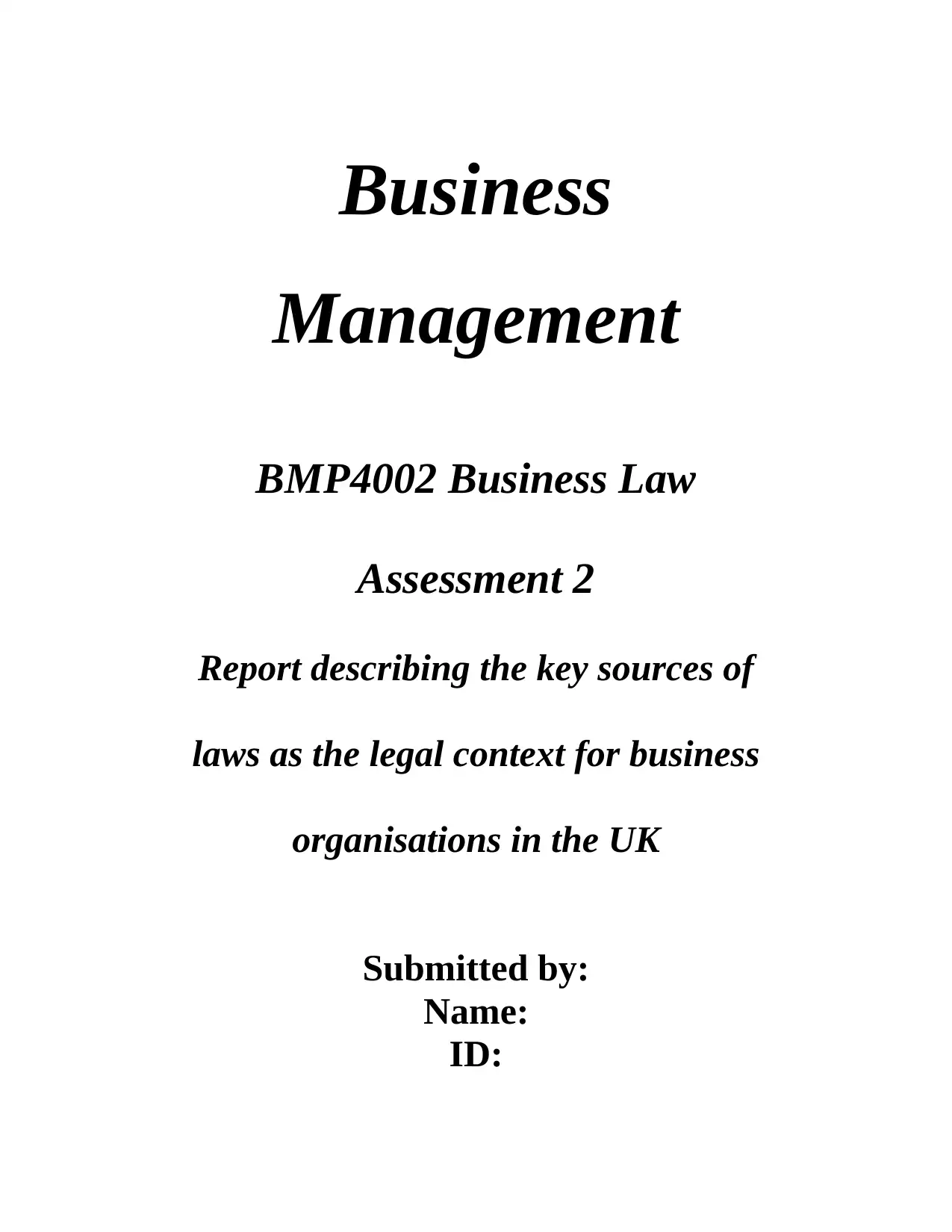
Business
Management
BMP4002 Business Law
Assessment 2
Report describing the key sources of
laws as the legal context for business
organisations in the UK
Submitted by:
Name:
ID:
Management
BMP4002 Business Law
Assessment 2
Report describing the key sources of
laws as the legal context for business
organisations in the UK
Submitted by:
Name:
ID:
Paraphrase This Document
Need a fresh take? Get an instant paraphrase of this document with our AI Paraphraser
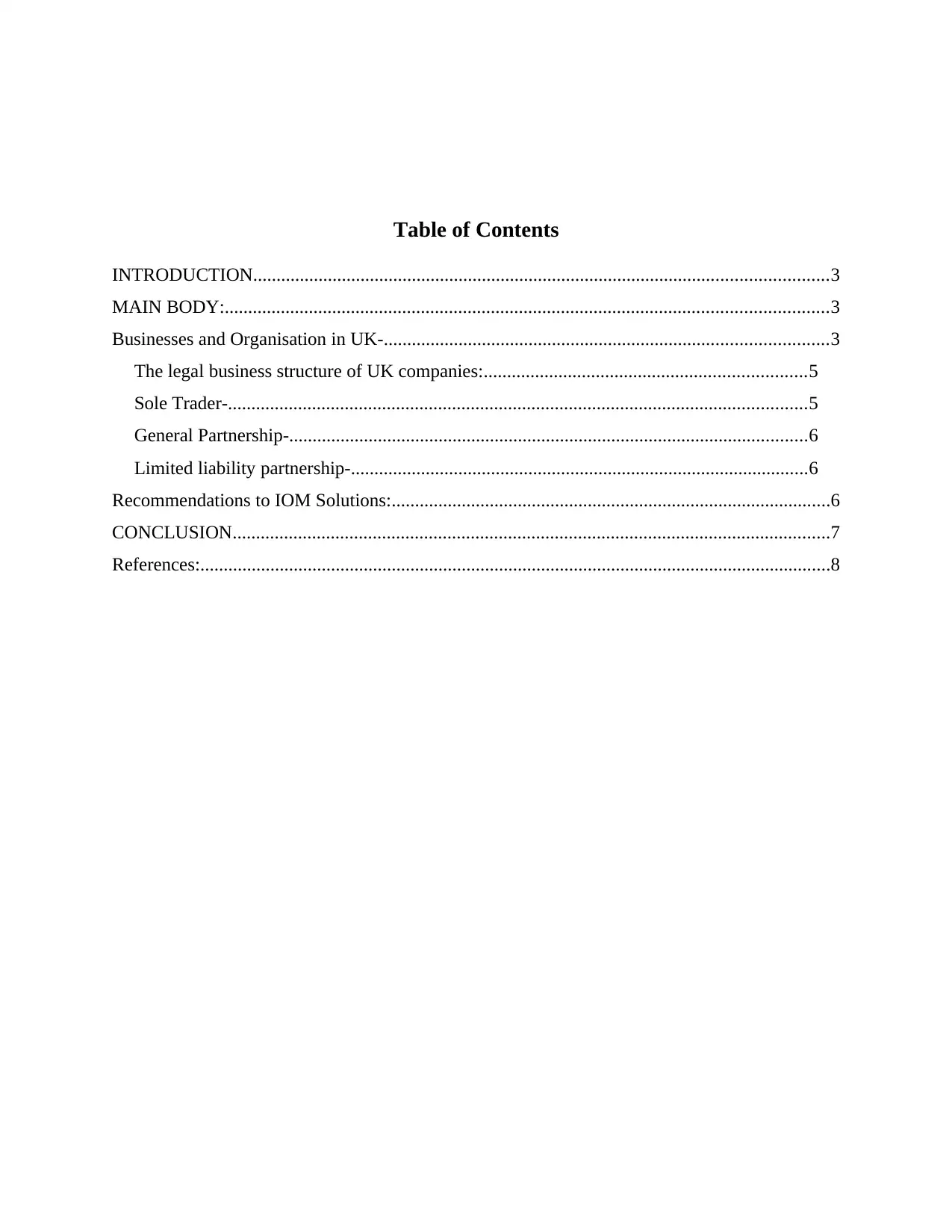
Table of Contents
INTRODUCTION...........................................................................................................................3
MAIN BODY:.................................................................................................................................3
Businesses and Organisation in UK-...............................................................................................3
The legal business structure of UK companies:.....................................................................5
Sole Trader-............................................................................................................................5
General Partnership-...............................................................................................................6
Limited liability partnership-..................................................................................................6
Recommendations to IOM Solutions:..............................................................................................6
CONCLUSION................................................................................................................................7
References:.......................................................................................................................................8
INTRODUCTION...........................................................................................................................3
MAIN BODY:.................................................................................................................................3
Businesses and Organisation in UK-...............................................................................................3
The legal business structure of UK companies:.....................................................................5
Sole Trader-............................................................................................................................5
General Partnership-...............................................................................................................6
Limited liability partnership-..................................................................................................6
Recommendations to IOM Solutions:..............................................................................................6
CONCLUSION................................................................................................................................7
References:.......................................................................................................................................8

INTRODUCTION
The term business can b explained as the activity of purchasing and selling goods and services in
order to earn profits. The main objective of the business is to earn more and more profits. But,
today in the modern world, the importance of corporate social responsibility is realised. Several
laws are now being made to fulfil this social responsibility of the company towards its
employees, society and environment(Bull, 2018). There are various forms of business namely
sole proprietorship, partnership, company, Hindu undivided family, etc. Moreover, the business
law of UK helps to create a legal understanding in terms of law. The business can also be divided
into three types on the basis of scale of production such as small, medium or large scale business.
This report explains about the different types of businesses. It further discusses about the merits
and demerits of these business. In the end section of this project, it explains about the type of
business that will best suit to IOM Solutions. The recommendations are based on the study or the
pros and cons of the different type of businesses that will best suit in the company IOM
Solutions.
MAIN BODY:
Businesses and Organisation in UK-
The main regulatory act that controls the businesses of UK is Companies Act, 2006. The
Insolvency Act,1986 also governs the business that become insolvent. It provides for the
procedure of insolvency and its consequences. Moreover, the Equality Act 2010, Employment
Right Act, 1996 also governs the employment rules and regulations of the employees of the
company. The act prescribes the procedure for incorporation, management, registration, etc. for
any company holding its business in UK (Giliker, 2018). It also provides for the provisions
where the company is holding its business in foreign countries. It also clarifies about the
The term business can b explained as the activity of purchasing and selling goods and services in
order to earn profits. The main objective of the business is to earn more and more profits. But,
today in the modern world, the importance of corporate social responsibility is realised. Several
laws are now being made to fulfil this social responsibility of the company towards its
employees, society and environment(Bull, 2018). There are various forms of business namely
sole proprietorship, partnership, company, Hindu undivided family, etc. Moreover, the business
law of UK helps to create a legal understanding in terms of law. The business can also be divided
into three types on the basis of scale of production such as small, medium or large scale business.
This report explains about the different types of businesses. It further discusses about the merits
and demerits of these business. In the end section of this project, it explains about the type of
business that will best suit to IOM Solutions. The recommendations are based on the study or the
pros and cons of the different type of businesses that will best suit in the company IOM
Solutions.
MAIN BODY:
Businesses and Organisation in UK-
The main regulatory act that controls the businesses of UK is Companies Act, 2006. The
Insolvency Act,1986 also governs the business that become insolvent. It provides for the
procedure of insolvency and its consequences. Moreover, the Equality Act 2010, Employment
Right Act, 1996 also governs the employment rules and regulations of the employees of the
company. The act prescribes the procedure for incorporation, management, registration, etc. for
any company holding its business in UK (Giliker, 2018). It also provides for the provisions
where the company is holding its business in foreign countries. It also clarifies about the
⊘ This is a preview!⊘
Do you want full access?
Subscribe today to unlock all pages.

Trusted by 1+ million students worldwide
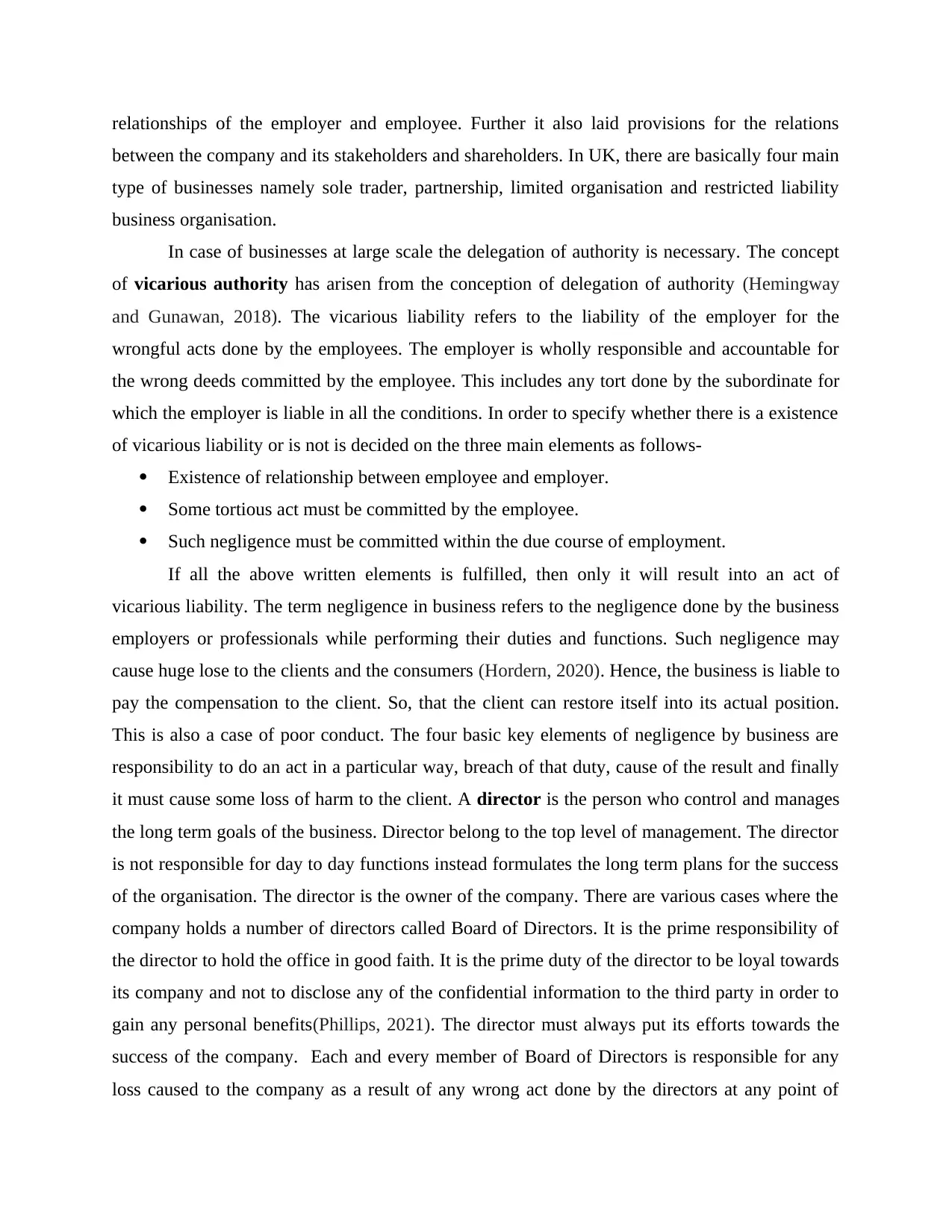
relationships of the employer and employee. Further it also laid provisions for the relations
between the company and its stakeholders and shareholders. In UK, there are basically four main
type of businesses namely sole trader, partnership, limited organisation and restricted liability
business organisation.
In case of businesses at large scale the delegation of authority is necessary. The concept
of vicarious authority has arisen from the conception of delegation of authority (Hemingway
and Gunawan, 2018). The vicarious liability refers to the liability of the employer for the
wrongful acts done by the employees. The employer is wholly responsible and accountable for
the wrong deeds committed by the employee. This includes any tort done by the subordinate for
which the employer is liable in all the conditions. In order to specify whether there is a existence
of vicarious liability or is not is decided on the three main elements as follows-
Existence of relationship between employee and employer.
Some tortious act must be committed by the employee.
Such negligence must be committed within the due course of employment.
If all the above written elements is fulfilled, then only it will result into an act of
vicarious liability. The term negligence in business refers to the negligence done by the business
employers or professionals while performing their duties and functions. Such negligence may
cause huge lose to the clients and the consumers (Hordern, 2020). Hence, the business is liable to
pay the compensation to the client. So, that the client can restore itself into its actual position.
This is also a case of poor conduct. The four basic key elements of negligence by business are
responsibility to do an act in a particular way, breach of that duty, cause of the result and finally
it must cause some loss of harm to the client. A director is the person who control and manages
the long term goals of the business. Director belong to the top level of management. The director
is not responsible for day to day functions instead formulates the long term plans for the success
of the organisation. The director is the owner of the company. There are various cases where the
company holds a number of directors called Board of Directors. It is the prime responsibility of
the director to hold the office in good faith. It is the prime duty of the director to be loyal towards
its company and not to disclose any of the confidential information to the third party in order to
gain any personal benefits(Phillips, 2021). The director must always put its efforts towards the
success of the company. Each and every member of Board of Directors is responsible for any
loss caused to the company as a result of any wrong act done by the directors at any point of
between the company and its stakeholders and shareholders. In UK, there are basically four main
type of businesses namely sole trader, partnership, limited organisation and restricted liability
business organisation.
In case of businesses at large scale the delegation of authority is necessary. The concept
of vicarious authority has arisen from the conception of delegation of authority (Hemingway
and Gunawan, 2018). The vicarious liability refers to the liability of the employer for the
wrongful acts done by the employees. The employer is wholly responsible and accountable for
the wrong deeds committed by the employee. This includes any tort done by the subordinate for
which the employer is liable in all the conditions. In order to specify whether there is a existence
of vicarious liability or is not is decided on the three main elements as follows-
Existence of relationship between employee and employer.
Some tortious act must be committed by the employee.
Such negligence must be committed within the due course of employment.
If all the above written elements is fulfilled, then only it will result into an act of
vicarious liability. The term negligence in business refers to the negligence done by the business
employers or professionals while performing their duties and functions. Such negligence may
cause huge lose to the clients and the consumers (Hordern, 2020). Hence, the business is liable to
pay the compensation to the client. So, that the client can restore itself into its actual position.
This is also a case of poor conduct. The four basic key elements of negligence by business are
responsibility to do an act in a particular way, breach of that duty, cause of the result and finally
it must cause some loss of harm to the client. A director is the person who control and manages
the long term goals of the business. Director belong to the top level of management. The director
is not responsible for day to day functions instead formulates the long term plans for the success
of the organisation. The director is the owner of the company. There are various cases where the
company holds a number of directors called Board of Directors. It is the prime responsibility of
the director to hold the office in good faith. It is the prime duty of the director to be loyal towards
its company and not to disclose any of the confidential information to the third party in order to
gain any personal benefits(Phillips, 2021). The director must always put its efforts towards the
success of the company. Each and every member of Board of Directors is responsible for any
loss caused to the company as a result of any wrong act done by the directors at any point of
Paraphrase This Document
Need a fresh take? Get an instant paraphrase of this document with our AI Paraphraser

time. Every director must exercise due care, diligence while performing its functions and duties.
It is the duty of the director to act within the prescribed powers of law. The director must avoid
the conflicts regarding the interest of the employees. The director is responsible to pay the
creditors in the condition of insolvency of the company under the Insolvency Act, 1986. It is the
liability of the director to pay back its illegitimate benefits arising due to its illegal acts. The
director can further face criminal charges or loss of money due to its criminal acts. The director
may even face the condition where he is banned from the seat of director. The Partnership Act,
1890 laid the provisions regarding the partnership firms in United Kingdom. The partnership
firm in UK can be terminated in five ways. Firstly, it can be dissolved by agreement between
both the parties. Secondly, it can be terminated by notice. Thirdly, it can be extinct by the end of
expiry period of partnership firm. Fourthly, in case of death of any of the partner of the firm.
Fifthly, it can be liquefied by the court order(Tawiah, 2021).
There are two main documents that are necessary to establish a company namely
Memorandum of Association and Article of Association. Both of them are created and issued
during the initial process of forming a company. The MOA is a one page document that specifies
the name of the subscribers and their legal intention to create such company in the eyes of law.
The Article of Association consists of number of pages. It specifies about the rules and
regulations of the company which is to be followed by every member of the company. Every
employer, employee and director is bound to follow such rules as prescribed in the AOA.
The legal business structure of UK companies:
Sole Trader-
The sole trader is the person who is engaged in its own business. The sole trader is wholly
responsible for its business. The formation of sole proprietor firm is through HMRC registration.
The merits of sole trader is its simplicity as it is easy to form. It has high level of confidentiality
as of only one owner. It requires less administration and report. It is more flexible. The demerits
is it involves personal liability. It faces problem while raising capital. It is less tax efficient as the
owner has to pay personally all the tax of the firm. In case of insolvency, the sole proprietor has
to pay even from its personal assets(Test, 2021). The sole proprietor has to manage its own
business. He is responsible for the finance and management of its firm. In this, if the business
It is the duty of the director to act within the prescribed powers of law. The director must avoid
the conflicts regarding the interest of the employees. The director is responsible to pay the
creditors in the condition of insolvency of the company under the Insolvency Act, 1986. It is the
liability of the director to pay back its illegitimate benefits arising due to its illegal acts. The
director can further face criminal charges or loss of money due to its criminal acts. The director
may even face the condition where he is banned from the seat of director. The Partnership Act,
1890 laid the provisions regarding the partnership firms in United Kingdom. The partnership
firm in UK can be terminated in five ways. Firstly, it can be dissolved by agreement between
both the parties. Secondly, it can be terminated by notice. Thirdly, it can be extinct by the end of
expiry period of partnership firm. Fourthly, in case of death of any of the partner of the firm.
Fifthly, it can be liquefied by the court order(Tawiah, 2021).
There are two main documents that are necessary to establish a company namely
Memorandum of Association and Article of Association. Both of them are created and issued
during the initial process of forming a company. The MOA is a one page document that specifies
the name of the subscribers and their legal intention to create such company in the eyes of law.
The Article of Association consists of number of pages. It specifies about the rules and
regulations of the company which is to be followed by every member of the company. Every
employer, employee and director is bound to follow such rules as prescribed in the AOA.
The legal business structure of UK companies:
Sole Trader-
The sole trader is the person who is engaged in its own business. The sole trader is wholly
responsible for its business. The formation of sole proprietor firm is through HMRC registration.
The merits of sole trader is its simplicity as it is easy to form. It has high level of confidentiality
as of only one owner. It requires less administration and report. It is more flexible. The demerits
is it involves personal liability. It faces problem while raising capital. It is less tax efficient as the
owner has to pay personally all the tax of the firm. In case of insolvency, the sole proprietor has
to pay even from its personal assets(Test, 2021). The sole proprietor has to manage its own
business. He is responsible for the finance and management of its firm. In this, if the business

goes in loss, then the sole proprietor has to pay from his personal assets in order to pay back the
creditors of the firm . The name of sole proprietor is involved in his business.
General Partnership-
The Partnership Act, 1890 provide for the provisions of partnership firm in UK. Partnership
refers to a contract done by two or more persons to do a business in order to earn profits. The
partnership firm does not need any type of registration. All are partners are legally entitled to
benefits and personal liability of the partnership firm. The merits of the partnership firm is that it
requires less legal obligations to fulfil. It is very easy to start. It also shares the burden. It helps in
taking better decisions. Privacy is also maintained in this form of business. Its main demerits
include unlimited liability, lack of access to capital, etc. It also has the capability that there may
be conflicts between the partners. It further takes more time to take decision. The profits is also
being shared between the partners. The tax efficiency is lack in this type of business(Travis,
2019).
Limited liability partnership-
In this type of partnership, the liability of the partners are limited. The LLP can be
formed with minimum of two members. The LLP has to be registered with Companies House.
The merits of LLP is that it protects the partners from unlimited liability. The profit is also
divided among the partners. Moreover, no need of capital investment by the partners. It requires
low registration fees. DDT is also not applied to LLP. The demerits are one partner has to give
unlimited liability to the firm which is the loss to that partner as the other partners enjoy the
limited liability (Werneck and Saadi , 2019). In case of loss in business, they have to face lose in
capital contribution by the other partners. It needs more penalties to the partner. It also face
difficulty in raising funding. There is no provision for filing tax as a firm, but if the turnover of
the firm increases to £85,000, then they have to register for VAT. Otherwise, they have to
pay tax individually.
creditors of the firm . The name of sole proprietor is involved in his business.
General Partnership-
The Partnership Act, 1890 provide for the provisions of partnership firm in UK. Partnership
refers to a contract done by two or more persons to do a business in order to earn profits. The
partnership firm does not need any type of registration. All are partners are legally entitled to
benefits and personal liability of the partnership firm. The merits of the partnership firm is that it
requires less legal obligations to fulfil. It is very easy to start. It also shares the burden. It helps in
taking better decisions. Privacy is also maintained in this form of business. Its main demerits
include unlimited liability, lack of access to capital, etc. It also has the capability that there may
be conflicts between the partners. It further takes more time to take decision. The profits is also
being shared between the partners. The tax efficiency is lack in this type of business(Travis,
2019).
Limited liability partnership-
In this type of partnership, the liability of the partners are limited. The LLP can be
formed with minimum of two members. The LLP has to be registered with Companies House.
The merits of LLP is that it protects the partners from unlimited liability. The profit is also
divided among the partners. Moreover, no need of capital investment by the partners. It requires
low registration fees. DDT is also not applied to LLP. The demerits are one partner has to give
unlimited liability to the firm which is the loss to that partner as the other partners enjoy the
limited liability (Werneck and Saadi , 2019). In case of loss in business, they have to face lose in
capital contribution by the other partners. It needs more penalties to the partner. It also face
difficulty in raising funding. There is no provision for filing tax as a firm, but if the turnover of
the firm increases to £85,000, then they have to register for VAT. Otherwise, they have to
pay tax individually.
⊘ This is a preview!⊘
Do you want full access?
Subscribe today to unlock all pages.

Trusted by 1+ million students worldwide
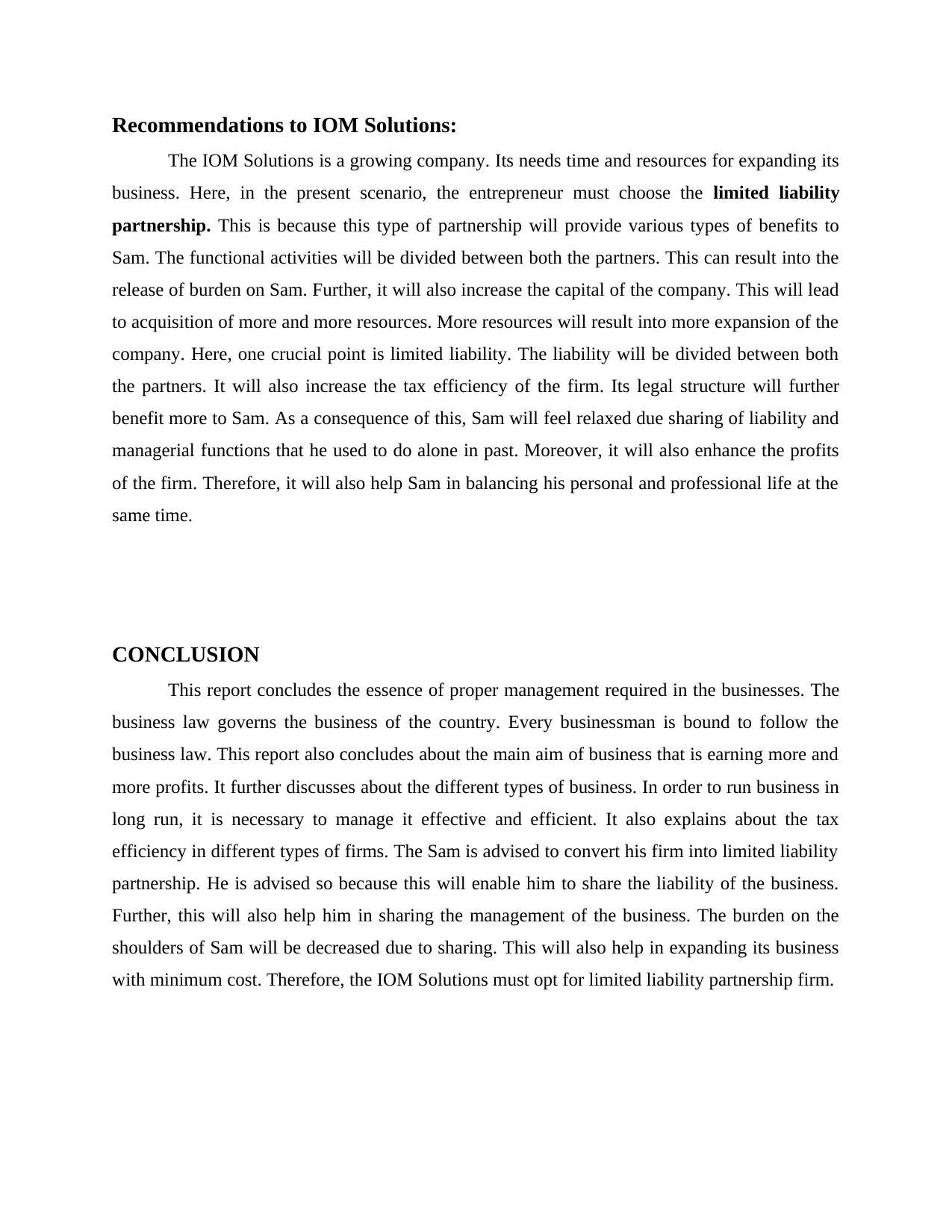
Recommendations to IOM Solutions:
The IOM Solutions is a growing company. Its needs time and resources for expanding its
business. Here, in the present scenario, the entrepreneur must choose the limited liability
partnership. This is because this type of partnership will provide various types of benefits to
Sam. The functional activities will be divided between both the partners. This can result into the
release of burden on Sam. Further, it will also increase the capital of the company. This will lead
to acquisition of more and more resources. More resources will result into more expansion of the
company. Here, one crucial point is limited liability. The liability will be divided between both
the partners. It will also increase the tax efficiency of the firm. Its legal structure will further
benefit more to Sam. As a consequence of this, Sam will feel relaxed due sharing of liability and
managerial functions that he used to do alone in past. Moreover, it will also enhance the profits
of the firm. Therefore, it will also help Sam in balancing his personal and professional life at the
same time.
CONCLUSION
This report concludes the essence of proper management required in the businesses. The
business law governs the business of the country. Every businessman is bound to follow the
business law. This report also concludes about the main aim of business that is earning more and
more profits. It further discusses about the different types of business. In order to run business in
long run, it is necessary to manage it effective and efficient. It also explains about the tax
efficiency in different types of firms. The Sam is advised to convert his firm into limited liability
partnership. He is advised so because this will enable him to share the liability of the business.
Further, this will also help him in sharing the management of the business. The burden on the
shoulders of Sam will be decreased due to sharing. This will also help in expanding its business
with minimum cost. Therefore, the IOM Solutions must opt for limited liability partnership firm.
The IOM Solutions is a growing company. Its needs time and resources for expanding its
business. Here, in the present scenario, the entrepreneur must choose the limited liability
partnership. This is because this type of partnership will provide various types of benefits to
Sam. The functional activities will be divided between both the partners. This can result into the
release of burden on Sam. Further, it will also increase the capital of the company. This will lead
to acquisition of more and more resources. More resources will result into more expansion of the
company. Here, one crucial point is limited liability. The liability will be divided between both
the partners. It will also increase the tax efficiency of the firm. Its legal structure will further
benefit more to Sam. As a consequence of this, Sam will feel relaxed due sharing of liability and
managerial functions that he used to do alone in past. Moreover, it will also enhance the profits
of the firm. Therefore, it will also help Sam in balancing his personal and professional life at the
same time.
CONCLUSION
This report concludes the essence of proper management required in the businesses. The
business law governs the business of the country. Every businessman is bound to follow the
business law. This report also concludes about the main aim of business that is earning more and
more profits. It further discusses about the different types of business. In order to run business in
long run, it is necessary to manage it effective and efficient. It also explains about the tax
efficiency in different types of firms. The Sam is advised to convert his firm into limited liability
partnership. He is advised so because this will enable him to share the liability of the business.
Further, this will also help him in sharing the management of the business. The burden on the
shoulders of Sam will be decreased due to sharing. This will also help in expanding its business
with minimum cost. Therefore, the IOM Solutions must opt for limited liability partnership firm.
Paraphrase This Document
Need a fresh take? Get an instant paraphrase of this document with our AI Paraphraser

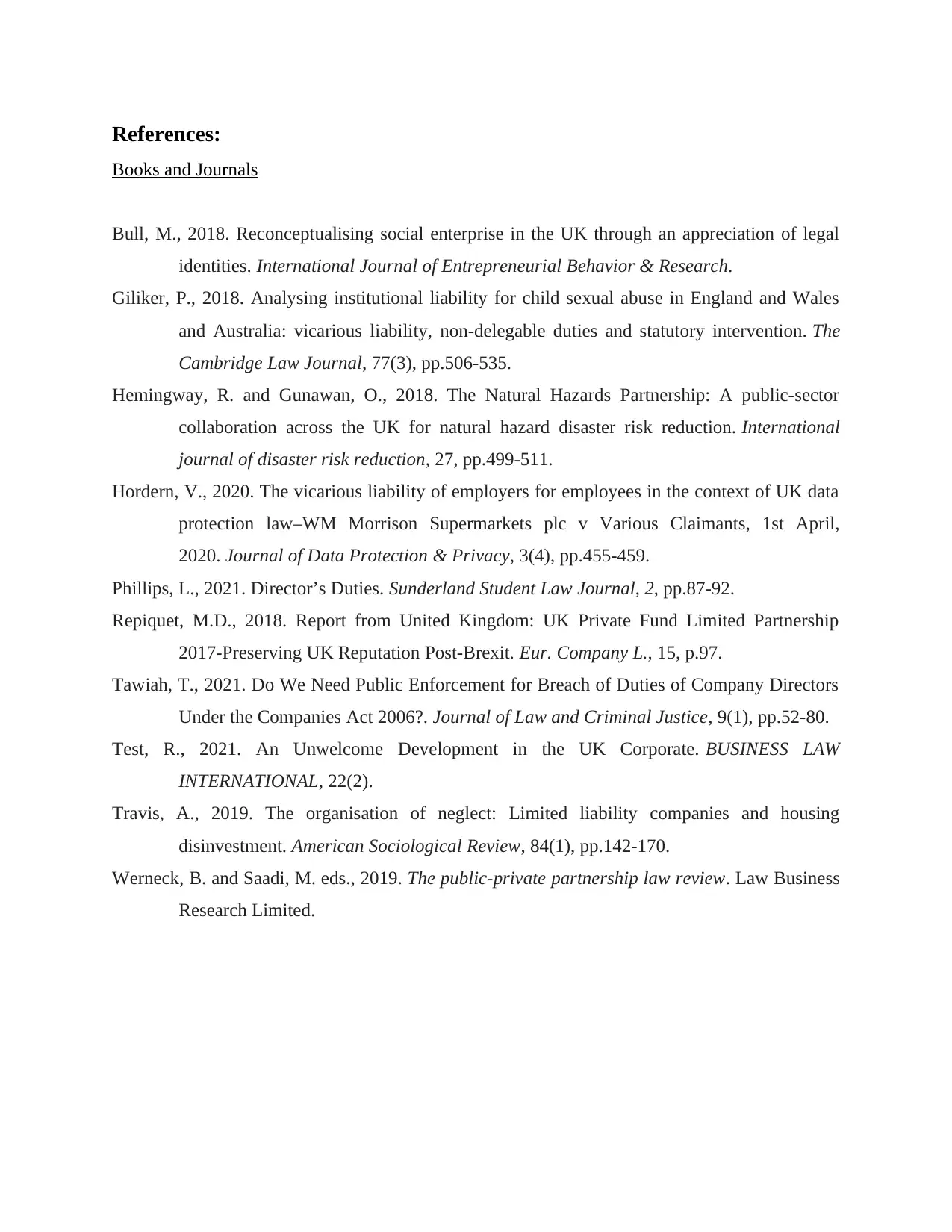
References:
Books and Journals
Bull, M., 2018. Reconceptualising social enterprise in the UK through an appreciation of legal
identities. International Journal of Entrepreneurial Behavior & Research.
Giliker, P., 2018. Analysing institutional liability for child sexual abuse in England and Wales
and Australia: vicarious liability, non-delegable duties and statutory intervention. The
Cambridge Law Journal, 77(3), pp.506-535.
Hemingway, R. and Gunawan, O., 2018. The Natural Hazards Partnership: A public-sector
collaboration across the UK for natural hazard disaster risk reduction. International
journal of disaster risk reduction, 27, pp.499-511.
Hordern, V., 2020. The vicarious liability of employers for employees in the context of UK data
protection law–WM Morrison Supermarkets plc v Various Claimants, 1st April,
2020. Journal of Data Protection & Privacy, 3(4), pp.455-459.
Phillips, L., 2021. Director’s Duties. Sunderland Student Law Journal, 2, pp.87-92.
Repiquet, M.D., 2018. Report from United Kingdom: UK Private Fund Limited Partnership
2017-Preserving UK Reputation Post-Brexit. Eur. Company L., 15, p.97.
Tawiah, T., 2021. Do We Need Public Enforcement for Breach of Duties of Company Directors
Under the Companies Act 2006?. Journal of Law and Criminal Justice, 9(1), pp.52-80.
Test, R., 2021. An Unwelcome Development in the UK Corporate. BUSINESS LAW
INTERNATIONAL, 22(2).
Travis, A., 2019. The organisation of neglect: Limited liability companies and housing
disinvestment. American Sociological Review, 84(1), pp.142-170.
Werneck, B. and Saadi, M. eds., 2019. The public-private partnership law review. Law Business
Research Limited.
Books and Journals
Bull, M., 2018. Reconceptualising social enterprise in the UK through an appreciation of legal
identities. International Journal of Entrepreneurial Behavior & Research.
Giliker, P., 2018. Analysing institutional liability for child sexual abuse in England and Wales
and Australia: vicarious liability, non-delegable duties and statutory intervention. The
Cambridge Law Journal, 77(3), pp.506-535.
Hemingway, R. and Gunawan, O., 2018. The Natural Hazards Partnership: A public-sector
collaboration across the UK for natural hazard disaster risk reduction. International
journal of disaster risk reduction, 27, pp.499-511.
Hordern, V., 2020. The vicarious liability of employers for employees in the context of UK data
protection law–WM Morrison Supermarkets plc v Various Claimants, 1st April,
2020. Journal of Data Protection & Privacy, 3(4), pp.455-459.
Phillips, L., 2021. Director’s Duties. Sunderland Student Law Journal, 2, pp.87-92.
Repiquet, M.D., 2018. Report from United Kingdom: UK Private Fund Limited Partnership
2017-Preserving UK Reputation Post-Brexit. Eur. Company L., 15, p.97.
Tawiah, T., 2021. Do We Need Public Enforcement for Breach of Duties of Company Directors
Under the Companies Act 2006?. Journal of Law and Criminal Justice, 9(1), pp.52-80.
Test, R., 2021. An Unwelcome Development in the UK Corporate. BUSINESS LAW
INTERNATIONAL, 22(2).
Travis, A., 2019. The organisation of neglect: Limited liability companies and housing
disinvestment. American Sociological Review, 84(1), pp.142-170.
Werneck, B. and Saadi, M. eds., 2019. The public-private partnership law review. Law Business
Research Limited.
⊘ This is a preview!⊘
Do you want full access?
Subscribe today to unlock all pages.

Trusted by 1+ million students worldwide
1 out of 9
Related Documents
Your All-in-One AI-Powered Toolkit for Academic Success.
+13062052269
info@desklib.com
Available 24*7 on WhatsApp / Email
![[object Object]](/_next/static/media/star-bottom.7253800d.svg)
Unlock your academic potential
Copyright © 2020–2025 A2Z Services. All Rights Reserved. Developed and managed by ZUCOL.

